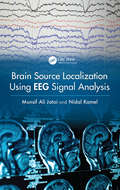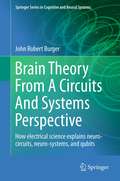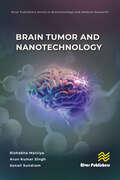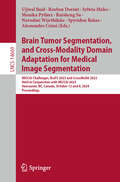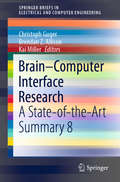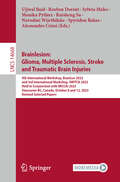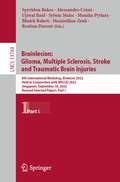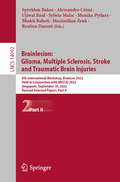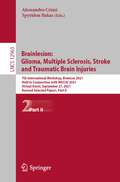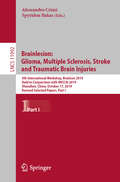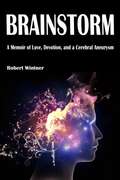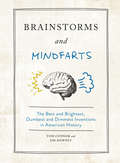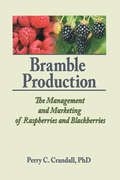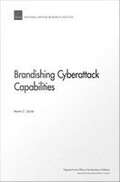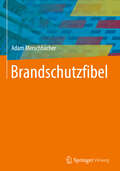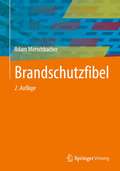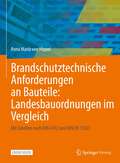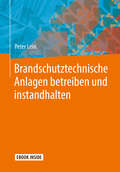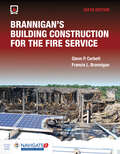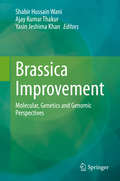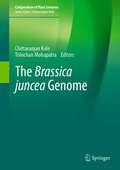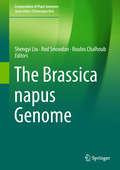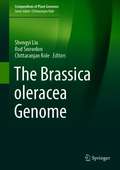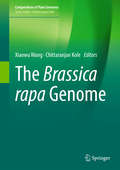- Table View
- List View
Brain Source Localization Using EEG Signal Analysis
by Munsif Ali Jatoi Nidal KamelOf the research areas devoted to biomedical sciences, the study of the brain remains a field that continually attracts interest due to the vast range of people afflicted with debilitating brain disorders and those interested in ameliorating its effects. To discover the roots of maladies and grasp the dynamics of brain functions, researchers and practitioners often turn to a process known as brain source localization, which assists in determining the source of electromagnetic signals from the brain. Aiming to promote both treatments and understanding of brain ailments, ranging from epilepsy and depression to schizophrenia and Parkinson’s disease, the authors of this book provide a comprehensive account of current developments in the use of neuroimaging techniques for brain analysis. Their book addresses a wide array of topics, including EEG forward and inverse problems, the application of classical MNE, LORETA, Bayesian based MSP, and its modified version, M-MSP. Within the ten chapters that comprise this book, clinicians, researchers, and field experts concerned with the state of brain source localization will find a store of information that can assist them in the quest to enhance the quality of life for people living with brain disorders.
Brain Theory From A Circuits And Systems Perspective: How Electrical Science Explains Neuro-circuits, Neuro-systems, and Qubits (Springer Series in Cognitive and Neural Systems #6)
by John Robert BurgerThis book models an idealized neuron as being driven by basic electrical elements, the goal being to systematically characterize the logical properties of neural pulses. In order to constitute a system, neurons as pulsating devices may be represented using novel circuit elements as delineated in this book. A plausible brain system is implied by the delineated elements and logically follows from known and likely properties of a neuron. New to electrical science are novel pulse-related circuit elements involving recursive neurons. A recursive neuron, when properly excited, produces a self-sustaining pulse train that when sampled, provides a true output with a specified probability, and a false output with complementary probability. Because of its similarity to the qubits of quantum mechanics, the recursive pulsating neuron is termed a simulated qubit. Recursive neurons easily function as controlled toggle devices and so are capable of massively parallel calculations, this being a new dimension in brain functioning as described in this book. Simulated qubits and their possibilities are compared to the qubits of quantum physics. Included in the book are suggested neural circuits for associative memory search via a randomized process of cue selection, and neural circuits for priority calculations. These serve to select returns from long term memory, which in turn determines one's next conscious thought or action based on past memorized experiences. The book reports on proposals involving electron tunneling between synapses, and quantum computations within neurons. Although not a textbook, there are easy exercises at the ends of chapters, and in the appendix there are twelve simulation experiments concerning neurons.
Brain Tumor and Nanotechnology (River Publishers Series in Biotechnology and Medical Research)
by Arun Kumar Singh Rishabha Malviya Sonali SundramBrain Tumors and Nanotechnology explores the complex world of brain tumors and the ground-breaking role that nanotechnology is playing in both detection and treatment. It offers comprehensive and up-to-date strategies in the treatment of brain tumors, with a special emphasis on the revolutionary impact of nanotechnology. It begins with an in-depth analysis of the anatomy of the brain and nervous system, highlighting the constituents of the central nervous system (CNS) such as neurons and glial cells. It also offers a thorough understanding of the intricate structure of the human brain, including the hemispheres, brainstem, diencephalon, and ventricular system. It then reveals the understanding of the complicated nature of brain tumors and the potential for nanotechnology to revolutionize their diagnosis and treatment. Brain Tumors and Nanotechnology will be a longstanding valuable resource for researchers, medical professionals, and students in the field.
Brain Tumor Segmentation, and Cross-Modality Domain Adaptation for Medical Image Segmentation: MICCAI Challenges, BraTS 2023 and CrossMoDA 2023, Held in Conjunction with MICCAI 2023, Vancouver, BC, Canada, October 12 and 8, 2024, Proceedings (Lecture Notes in Computer Science #14669)
by Ujjwal Baid Reuben Dorent Sylwia Malec Monika Pytlarz Ruisheng Su Navodini Wijethilake Spyridon Bakas Alessandro CrimiThis book constitutes the refereed proceedings of the Brain Tumor Segmentation Challenge, BraTS 2023, as well as the Cross-Modality Domain Adaptation Challenge, CrossMoDA 2023. These events were held in conjunction with the Medical Image Computing for Computer Assisted Intervention Conference, MICCAI 2023, during October 8-12, 2023. The 37 full papers presented in this volume were selected form 23 submissions. They describe the research of computational scientists and clinical researchers working on brain lesions, and specifically glioma, multiple sclerosis, cerebral stroke, traumatic brain injuries, vestibular schwannoma, and white matter hyper-intensities of presumed vascular origin.
Brain–Computer Interface Research: A State-of-the-Art Summary 8 (SpringerBriefs in Electrical and Computer Engineering #6)
by Christoph Guger Brendan Z. Allison Kai MillerThe Annual BCI Research Awards are international prizes that recognize the top new projects in brain-computer interface (BCI) research. This book contains summaries of the key projects from the 2018 BCI Research Award. Each article is authored by the group of researchers who developed the project, and articles have been updated with new progress achieved since 2018. They are complemented by an introduction by the editors together with a chapter of highlights and interviews with the 2018 award winners. One of the prominent trends in recent years has been the development of BCIs for new patient groups; many chapters in this book present emerging and novel research directions likely to become more prevalent in the near future.
Brainlesion: 9th International Workshop, BrainLes 2023, and 3rd International Workshop, SWITCH 2023, Held in Conjunction with MICCAI 2023, Vancouver, BC, Canada, October 8 and 12, 2023, Revised Selected Papers (Lecture Notes in Computer Science #14668)
by Ujjwal Baid Reuben Dorent Sylwia Malec Monika Pytlarz Ruisheng Su Navodini Wijethilake Spyridon Bakas Alessandro CrimiThis book constitutes the refereed proceedings of the 9th International MICCAI Brain Lesion Workshop, BrainLes 2023, as well as the Stroke Workshop on Imaging and Treatment Challenges, SWITCH 2023. These events were held in conjunction with the Medical Image Computing for Computer Assisted Intervention Conference, MICCAI 2023, during October 8-12, 2023. The 15 revised full papers presented in this volume were selected form 23 submissions. They describe the research of computational scientists and clinical researchers working on brain lesions, and specifically glioma, multiple sclerosis, cerebral stroke, traumatic brain injuries, vestibular schwannoma, and white matter hyper-intensities of presumed vascular origin.
Brainlesion: 8th International Workshop, BrainLes 2022, Held in Conjunction with MICCAI 2022, Singapore, September 18, 2022, Revised Selected Papers (Lecture Notes in Computer Science #13769)
by Spyridon Bakas Alessandro Crimi Ujjwal Baid Sylwia Malec Monika Pytlarz Bhakti Baheti Maximilian Zenk Reuben DorentThis book constitutes the refereed proceedings of the 8th International MICCAI Brainlesion Workshop, BrainLes 2022, as well as the Brain Tumor Segmentation (BraTS) Challenge, the Brain Tumor Sequence Registration (BraTS-Reg) Challenge, the Cross-Modality Domain Adaptation (CrossMoDA) Challenge, and the Federated Tumor Segmentation (FeTS) Challenge. These were held jointly at the Medical Image Computing for Computer Assisted Intervention Conference, MICCAI 2022, in September 2022. The 46 revised full papers presented in these volumes were selected form 65 submissions.The presented contributions describe the research of computational scientists and clinical researchers working on brain lesions - specifically glioma, multiple sclerosis, cerebral stroke, traumatic brain injuries, vestibular schwannoma, and white matter hyper-intensities of presumed vascular origin.
Brainlesion: 8th International Workshop, BrainLes 2022, Held in Conjunction with MICCAI 2022, Singapore, September 18, 2022, Revised Selected Papers, Part II (Lecture Notes in Computer Science #14092)
by Spyridon Bakas Alessandro Crimi Ujjwal Baid Sylwia Malec Monika Pytlarz Bhakti Baheti Maximilian Zenk Reuben DorentThis two volume-set LNCS 13769 and LNCS 14092 constitutes the refereed proceedings of the 8th International MICCAI Brainlesion Workshop, BrainLes 2022, as well as the Brain Tumor Segmentation (BraTS) Challenge, the Brain Tumor Sequence Registration (BraTS-Reg) Challenge, the Cross-Modality Domain Adaptation (CrossMoDA) Challenge, and the Federated Tumor Segmentation (FeTS) Challenge. These were held jointly at the Medical Image Computing for Computer Assisted Intervention Conference, MICCAI 2022, in September 2022. The 46 revised full papers presented in these volumes were selected form 65 submissions.The presented contributions describe the research of computational scientists and clinical researchers working on brain lesions - specifically glioma, multiple sclerosis, cerebral stroke, traumatic brain injuries, vestibular schwannoma, and white matter hyper-intensities of presumed vascular origin.
Brainlesion: 7th International Workshop, BrainLes 2021, Held in Conjunction with MICCAI 2021, Virtual Event, September 27, 2021, Revised Selected Papers, Part II (Lecture Notes in Computer Science #12963)
by Alessandro Crimi Spyridon BakasThis two-volume set LNCS 12962 and 12963 constitutes the thoroughly refereed proceedings of the 7th International MICCAI Brainlesion Workshop, BrainLes 2021, as well as the RSNA-ASNR-MICCAI Brain Tumor Segmentation (BraTS) Challenge, the Federated Tumor Segmentation (FeTS) Challenge, the Cross-Modality Domain Adaptation (CrossMoDA) Challenge, and the challenge on Quantification of Uncertainties in Biomedical Image Quantification (QUBIQ). These were held jointly at the 23rd Medical Image Computing for Computer Assisted Intervention Conference, MICCAI 2020, in September 2021. The 91 revised papers presented in these volumes were selected form 151 submissions. Due to COVID-19 pandemic the conference was held virtually.
Brainlesion: 5th International Workshop, BrainLes 2019, Held in Conjunction with MICCAI 2019, Shenzhen, China, October 17, 2019, Revised Selected Papers, Part I (Lecture Notes in Computer Science #11992)
by Alessandro Crimi Spyridon BakasThe two-volume set LNCS 11992 and 11993 constitutes the thoroughly refereed proceedings of the 5th International MICCAI Brainlesion Workshop, BrainLes 2019, the International Multimodal Brain Tumor Segmentation (BraTS) challenge, the Computational Precision Medicine: Radiology-Pathology Challenge on Brain Tumor Classification (CPM-RadPath) challenge, as well as the tutorial session on Tools Allowing Clinical Translation of Image Computing Algorithms (TACTICAL). These were held jointly at the Medical Image Computing for Computer Assisted Intervention Conference, MICCAI, in Shenzhen, China, in October 2019. The revised selected papers presented in these volumes were organized in the following topical sections: brain lesion image analysis (12 selected papers from 32 submissions); brain tumor image segmentation (57 selected papers from 102 submissions); combined MRI and pathology brain tumor classification (4 selected papers from 5 submissions); tools allowing clinical translation of image computing algorithms (2 selected papers from 3 submissions.)
Brainstorm
by Robert WintnerNine million Americans are touched by aneurysms during their lifetime. This is one story of love.Brainstorm is the candid and powerful memoir of the author's harrowing experience of an aneurysm and his road to recovery. It is a journey of love, devotion, and a clash of medical beliefs and countercultures. The fierce resolve of the author and his wife is extraordinary, inspiring, and matched only by the tremendous competence and care of the medical system-one to which the author initially stands in opposition, but that he later learns to admire and respect.This book is for anyone who has experienced the fear and difficulties of a major illness. The themes, truths, and above all, the compassion that this book shares will be familiar not just to the nine million Americans affected by aneurysms, but to anyone whose family has been touched by a medical trauma. Filled with raw emotion, Brainstorm affords quiet but powerful support to those suffering similar circumstances and strives to tell them that they are not alone.
Brainstorms and Mindfarts: The Best and Brightest, Dumbest and Dimmest Inventions in American History
by Tom Connor Jim DowneyThis informative and occasionally bizarre collection of American inventions will help you discover successful and significant ideas—along with the frivolous and utterly useless ones lost to history. Innovation and entrepreneurism appear inextricably woven into the American DNA. Throughout American history, the great inventors and innovators gazed into the future and saw the products and services that would transform the world. While passionate about creating this new thing called a democracy, our Founding Fathers were also driven to change the way humans lived and worked—to complete everyday tasks faster, easier, and more efficiently.As of 2018, the U.S. Patent & Trademark Office had granted its ten millionth patent. But with over 500,000 applications now being filed annually, fewer than half of these applicants will be granted patents and far fewer still—an estimated one percent—will realize commercial success, according to the Office. Some are flawed by mistakes or missing details, others too ridiculous to take seriously, still others simply ahead of their time.From the brightest and most innovative to the wackiest, most bizarre, and downright crazy, this collection of 100 patents includes funny and informative descriptions and original illustrations, all the while letting you in on what most successful patents have in common, what inspired their creators, and how great inventors view the world.
Bramble Production
by Perry C. CrandallBramble Production provides growers with a basic understanding of how raspberry and blackberry plants grow and respond to changes in their environment. Author Perry Crandall includes management practices used by successful growers, making this book a helpful production guide that you can use for making rational decisions. This knowledge of successful production can be used to recommend or adopt management programs specially designed to produce optimum yields with maximum profits.
Brandishing Cyberattack Capabilities
by Martin C. LibickiDeterrence is possible only when others have at least a good idea of possible U.S. military reprisals, but cyberattack capabilities resist such demonstration. This report explores ways they can be and under what circumstances, then goes on to examine the difficulties and the drawbacks. Such "brandishing" is no panacea and could even backfire if misinterpreted. Its success also relies on the strength of other elements of the deterrence posture.
Brandschutzbeauftragte: Das Weiterbildungsbuch
by Wolfgang J. FriedlBrandschutz ist nicht nur gefordert und somit wichtig, nein – Brandschutz kann auch richtig interessant sein und Spaß machen! Brandschutz ist abwechslungsreich, und sich damit professionell zu beschäftigen, kann dem beruflichen Leben oft eine neue Zusatzrichtung und einen neuen Sinn geben. Dies beweist der bekannte Autor Dr. Wolfgang J. Friedl mit diesem neuen, umfangreichen und einzigartigen Fachbuch.Betriebliche Brandschutzbeauftragte müssen ihr Wissen alle drei Jahre in je 16 Unterrichtseinheiten á 45 min auf dem aktuellen Stand halten. Um diese Aufgabe auch ohne Präsenzveranstaltung möglich zu machen, wurde dieses umfangreiche Fachbuch zusammengestellt. Es enthält 16 Kapitel mit den wichtigsten Brandschutzthemen, inkl. praxisbezogener Tipps und Tricks, die u. a. auch im täglichen Leben zu Hause angewandt werden können. Der Lehr- und Lerneffekt dieses Fachbuchs im Vergleich zu einer Präsenzveranstaltung ist nicht nur effektiver und effizienter, sondern auch zeitlich besser einteilbar und ökologisch neutraler (da nicht mit An-/Abreise und Übernachtung verbunden). In freundlicher, informativer, direkter Art und manchmal auch mit einem leichten Augenzwickern, vermittelt der Autor, wie Brandschutz gelebt und umgesetzt wird. Freuen Sie sich drauf! Willkommen in der neuen Welt der Weiterbildung.
Brandschutzfibel
by Adam MerschbacherDie „Brandschutzfibel“ wird dem Fachmann für Brandschutz, dem interessierten Laien und den Beratern in Versicherungen, den Feuerwehren, sowie Herstellern in der Planung künftiger Brandschutzprodukte einen fundierten Überblick über wirkungsvolle und sinnvolle Brandschutzmaßnahmen im privaten und vor allem gewerblichen Umfeld geben. Das Wort „Gewerbe“ soll, auch wenn es nicht immer passend ist, für Unternehmen, Ladengeschäfte, Banken, Kirchen, Behörden, Museen, ja sogar für einen Zirkus und den Tierpark stehen. Dabei spielt die Größe überhaupt keine Rolle. Die Brandschutzrichtlinien gelten für die Würstelbude ebenso wie für größte Industrieunternehmen, in jeweils angepasster Form.
Brandschutzfibel
by Adam MerschbacherDie „Brandschutzfibel“ wird dem Fachmann für Brandschutz, dem interessierten Laien und den Beratern in Versicherungen, den Feuerwehren, sowie Herstellern in der Planung künftiger Brandschutzprodukte einen fundierten Überblick über wirkungsvolle und sinnvolle Brandschutzmaßnahmen im privaten und vor allem gewerblichen Umfeld geben. Das Wort „Gewerbe“ soll, auch wenn es nicht immer passend ist, für Unternehmen, Ladengeschäfte, Banken, Kirchen, Behörden, Museen, ja sogar für einen Zirkus und den Tierpark stehen. Dabei spielt die Größe überhaupt keine Rolle. Die Brandschutzrichtlinien gelten für die Würstelbude ebenso wie für größte Industrieunternehmen, in jeweils angepasster Form.
Brandschutztechnische Anforderungen an Bauteile: Mit Tabellen nach DIN 4102 und DIN EN 13501
by Anna Maria von HippelDas Bauordnungsrecht ist Landesrecht. 16 Landesbauordnungen sind in Deutschland nötig, um die brandschutztechnischen Anforderungen an Bauteile in dem Bundesgebiet zu regeln.Dieses Nachschlagewerk gibt eine Übersicht über die geltenden bauaufsichtlichen Anforderungen an Bauteile und verweist auf die gesetzlichen Fundstellen. Die bauaufsichtlichen Anforderungen werden in Tabellen zusammengestellt und nach DIN 4102 und DIN EN 13501 angegeben. Das Fachbuch gliedert sich in 3 Abschnitte. Im ersten Abschnitt werden Grundlagen dargestellt und Aufbau und Handhabung des Werks erläutert. Im zweiten Abschnitt wir ein bauteilbezogener und im dritten Abschnitt ein bundeslandbezogener Vergleich der bauaufsichtlichen Anforderungen an Bauteile dargestellt. Die Tabellensammlung im dritten Abschnitt schließt mit einer Synopse der gesetzlichen Fundstellen in den 16 Landesbauordnungen und der Musterbauordnung (MBO) ab.
Brandschutztechnische Anlagen betreiben und instandhalten
by Peter LeinDieses Fachbuch behandelt alle relevanten Aufgaben für ein bestimmungsgemäßes Betreiben und Instandhalten brandschutztechnischer Anlagen in Gebäuden. Brandschutztechnische Anlagen können nur dann ihre lebensrettende Funktion erfüllen, wenn Sie ordnungsgemäß gewartet und betrieben werden und in dem Zustand gehalten werden, den die gesetzlichen Vorgaben und die anerkannten Regeln der Technik fordern. Betreiber erhalten alle wesentlichen rechtlichen und technischen Hinweise, die sie für den Betrieb und die Instandhaltung benötigen.
Brannigan's Building Construction for the Fire Service includes Navigate Advantage Access
by Glenn P. Corbett Francis L. BranniganIn 1971, Francis L. Brannigan created Building Construction for the Fire Service, a groundbreaking resource offering the most comprehensive knowledge of building construction available to fire fighters. With his dedication to fire fighter safety and saving lives, the legacy of Frank Brannigan continues with the sixth edition of Brannigan’s Building Construction for the Fire Service. The Sixth Edition meets and exceeds the National Fire Academy’s Fire and Emergency Services Higher Education (FESHE) course objectives and outcomes for the Associate’s Core-Level course called Building Construction for Fire Protection (C0275). Brannigan’s Building Construction for the Fire Service, Sixth Edition is an integral resource for fire officers, instructors, those studying for promotion, individuals taking civil service examinations, fire science students, and both current and prospective fire fighters. It is part of an integrated teaching and learning system that combines dynamic features and content to support instructors and to help prepare students for their career in firefighting. This new edition features: Chapter 7 Non-Fire Building Systems (new) describes several categories of non-fire systems in buildings, including electrical systems, plumbing systems, conveyances, refrigeration systems, and Ventilation (HVAC) systems, in addition to the hazards the systems pose for fire fighters. New or expanded content on: Aluminum-clad polyethylene panels Scaffolding Cranes and their use Modular construction using stacked shipping containers Light-weight wood-frame construction Fire escapes and stair design Cross-laminated timber and heavy timber construction Methods of protecting steel against fire New “green” materials and methods such as hempcrete and biofilters Structural wall framing systems with insulated studs Air-supported structures for sporting events Massive single-structure lightweight wood frame apartment buildings Firefighting recommendations in lightweight wood frame residential buildings Building construction and its relationship to flow path Historical perspective on fire resistance testing and its shortcomings Roofing material tests Safety issues of post-fire investigation of significantly damaged/collapsed buildings Scenario-Based Learning. Case Studies are found at the beginning and end of each chapter to encourage and foster critical-thinking skills. Tactical Considerations. This feature offers suggestions for firefighting, safety concerns, and related additional material for application on the fireground. Wrap-Up. Chapter Summaries, Key Terms, Challenging Questions, and Suggesting Readings promote comprehension and mastery of course objectives and outcomes.
Brassica Improvement: Molecular, Genetics and Genomic Perspectives
by Shabir Hussain Wani Ajay Kumar Thakur Yasin Jeshima KhanGlobal population is mounting at an alarming stride to surpass 9.3 billion by 2050, whereas simultaneously the agricultural productivity is gravely affected by climate changes resulting in increased biotic and abiotic stresses. The genus Brassica belongs to the mustard family whose members are known as cruciferous vegetables, cabbages or mustard plants. Rapeseed-mustard is world’s third most important source of edible oil after soybean and oil palm. It has worldwide acceptance owing to its rare combination of health promoting factors. It has very low levels of saturated fatty acids which make it the healthiest edible oil that is commonly available. Apart from this, it is rich in antioxidants by virtue of tocopherols and phytosterols presence in the oil. The high omega 3 content reduces the risk of atherosclerosis/heart attack. Conventional breeding methods have met with limited success in Brassica because yield and stress resilience are polygenic traits and are greatly influenced by environment. Therefore, it is imperative to accelerate the efforts to unravel the biochemical, physiological and molecular mechanisms underlying yield, quality and tolerance towards biotic and abiotic stresses in Brassica. To exploit its fullest potential, systematic efforts are needed to unlock the genetic information for new germplasms that tolerate initial and terminal state heat coupled with moisture stress. For instance, wild relatives may be exploited in developing introgressed and resynthesized lines with desirable attributes. Exploitation of heterosis is another important area which can be achieved by introducing transgenics to raise stable CMS lines. Doubled haploid breeding and marker assisted selection should be employed along with conventional breeding. Breeding programmes aim at enhancing resource use efficiency, especially nutrient and water as well as adoption to aberrant environmental changes should also be considered. Biotechnological interventions are essential for altering the biosynthetic pathways for developing high oleic and low linolenic lines. Accordingly, tools such as microspore and ovule culture, embryo rescue, isolation of trait specific genes especially for aphid, Sclerotinia and alternaria blight resistance, etc. along with identification of potential lines based on genetic diversity can assist ongoing breeding programmes. In this book, we highlight the recent molecular, genetic and genomic interventions made to achieve crop improvement in terms of yield increase, quality and stress tolerance in Brassica, with a special emphasis in Rapeseed-mustard.
The Brassica juncea Genome (Compendium of Plant Genomes)
by Chittaranjan Kole Trilochan MohapatraThis book is the first comprehensive compilation of deliberations on elucidation and augmentation of the genome of Brassica juncea, one of the leading oilseed crops of the world, popularly called as brown mustard, Indian mustard, Chinese mustard, or Oriental mustard. It includes discussions on genepools; genetic diversity and its characterization; classical genetic and traditional breeding; basics and application of heteroploidy; techniques and applications of introgressive hybridization; in vitro culture for micro-propagation, somatic mutation, somatic embryogenesis, and somatic hybridization; genetic engineering including genetic transformation and gene silencing; and molecular genetic mapping and mapping of genes and comprehensive delineations on genome sequencing and comparative genomics; resequencing for elucidation of origin and diversity; large-scale genome analysis; plastid genome sequence; transcriptomics; metabolomics; proteomics; evolutionary genomics; role of regulatory genes in development and adaptation and their utilization in trait improvement; precise breeding for yield, quality, and resistance to biotic and abiotic stresses; and prospects of genome editing.
The Brassica napus Genome (Compendium of Plant Genomes)
by Shengyi Liu Rod Snowdon Boulos ChalhoubThis book describes how the genome sequence contributes to our understanding of allopolyploidisation and the genome evolution, genetic diversity, complex trait regulation and knowledge-based breeding of this important crop. Numerous examples demonstrate how widespread homoeologous genome rearrangements and exchanges have moulded structural genome diversity following a severe polyploidy bottleneck. The allopolyploid crop species Brassica napus has the most highly duplicated plant genome to be assembled to date, with the largest number of annotated genes.Examples are provided for use of the genome sequence to identify and capture diversity for important agronomic traits, including seed quality and disease resistance. The increased potential for detailed gene discovery using high-density genetic mapping, quantitative genetics and transcriptomic analyses is described in the context of genome availability and illustrated with recent examples. Intimate knowledge of the highly-duplicated gene space, on the one hand, and the repeat landscape on the other, particularly in comparison to the two diploid progenitor genomes, provide a fundamental basis for new insights into the regulatory mechanisms that are coupled with selection for polyploid success and crop evolution.
The Brassica oleracea Genome (Compendium of Plant Genomes)
by Shengyi Liu Rod Snowdon Chittaranjan KoleThis book presents comprehensive information on genetics, genomics and breeding in Brassica oleracea, an agriculturally important species that includes popular vegetable crops such as cabbage, cauliflower, broccoli, Brussels sprouts, kale, collard greens, savoy, kohlrabi, and gai lan. The content spans whole genome sequencing, assembly and gene annotation for this global vegetable species, along with molecular mapping and cloning of genes, physical genome mapping and analyses of the structure and composition of centromeres in the B. oleracea genome. The book also elaborates on asymmetrical genome evolution and transposable elements in the B. oleracea describes gene family differentiation in comparison to other Brassica species and structural and functional genomic resources and data bases developed for B. oleracea. Useful discussions on the impact of genome sequencing on genetic improvement in the species are also included.
The Brassica rapa Genome
by Xiaowu Wang Chittaranjan KoleThis book provides insights into the latest achievements in genomics research on Brassica rapa. It describes the findings on this Brassica species, the first of the U's triangle that has been sequenced and a close relative to the model plant Arabidopsis, which provide a basis for investigations of major Brassica crop species. Further, the book focuses on the development of tools to facilitate the transfer of our rich knowledge on Arabidopsis to a cultivated Brassica crop. Key topics covered include genomic resources, assembly tools, annotation of the genome, transposable elements, comparative genomics, evolution of Brassica genomes, and advances in the application of genomics in the breeding of Brassica rapa crops.
